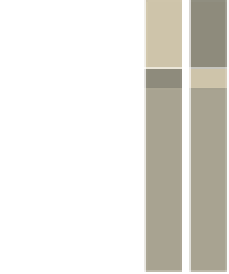Geoscience Reference
In-Depth Information
'Upper' 2-layer case
+
'Lower' 2-layer case
=
3-layer case
Apparent resistivity ( m)
Apparent resistivity ( m)
Apparent resistivity ( m)
10
1
10
2
10
1
10
2
1
0
1
10
2
10
0
10
0
10
0
50
m
50
10
m
m
10
( m)
10
1
10 m
10
1
10
1
10 m
20 m
20 m
Combined
response
10
2
10
2
10
2
Response
due to
upper
interface
10
250
250
m
m
m
10
3
10
3
10
3
Response
due to
lower
interface
10
4
10
4
10
4
Low
(10 m)
Medium
(50 m)
High
(250 m)
Low
(10 m)
Medium
(50 m)
High
(250 m)
Low
(10 m)
Medium
(50 m)
High
(250 m)
Figure 5.44
Computed Schlumberger array VES resistivity curves showing a three-layer response as a combination of two two-layer responses.
Apparent resistivity ( m)
Apparent resistivity ( m)
1
0
1
Apparent resistivity ( m)
10
1
1
0
1
10
2
10
2
10
2
10
0
10
0
10
0
50
m
50
10
250
10
250
m
m
m
m
m
10
1
10 m
20 m
10
1
10
1
10 m
20 m
10 m
20 m
C
D
E
F
250
10
250
10
50
50
m
m
m
m
m
m
10
2
10
2
10
2
A
B
10
250
50
50
250
10
m
m
m
m
m
m
10
3
10
3
10
3
10
4
10
4
10
4
AB
CD
E F
Low
(10 m)
Medium
(50 m)
High
(250 m)
Low
(10 m)
Medium
(50 m)
High
(250 m)
Low
(10 m)
Medium
(50 m)
High
(250 m)
Figure 5.45
Computed Schlumberger array VES resistivity curves for a three-layer ground illustrating the various forms of the responses for the
six (A
-
F) possible combinations of relative resistivity.
possible, removal of its effects from other forms of geo-
physical data.
intermediate resistivity. Clearly, the depth of erosion is
expected to be a fundamental influence on the electrical
responses of kimberlites. In addition to responses from the
kimberlite itself, preferential erosion often causes the pipes
to be overlain by a layer of young sedimentary materials,
which may also produce geophysical responses useful for
locating kimberlites.
Vertical electric soundings were made within and out-
side the pipe to investigate changes in electrical properties
with depth (
Figs. 5.46c
and
d
). The Schlumberger array
was used with a maximum current electrode separation
(X
AB
) of 280 m for the sounding centred within the pipe
(VES1), with the sounding of the country rock outside the
pipe (VES32) made to a separation of 1200 m. Both
sounding curves show a basic three-layer medium
Example - Palmietfontein kimberlite
Resistivity surveys in and around the Palmietfontein kim-
berlite pipe, North West Province, South Africa, illustrate
their application to mapping the extent and internal struc-
ture of kimberlites (da Costa,
1989
). The Palmietfontein
kimberlite is large for a kimberlite, covering an area of
about 12 ha. There has been little erosion of the pipe and
the yellow ground, blue ground and hardebank are all
preserved. These layers have distinctly different physical
properties. The yellow ground, being hydrated and oxi-
dised kimberlite, is mainly composed of clay minerals and
has the lowest resistivity of the three layers. The fresh rock
comprising the hardebank is the most resistive, and the
partially weathered and serpentinised blue ground is of
-
using 1D models. The country rock sounding was
-
low



































































































































































































































Search WWH ::

Custom Search